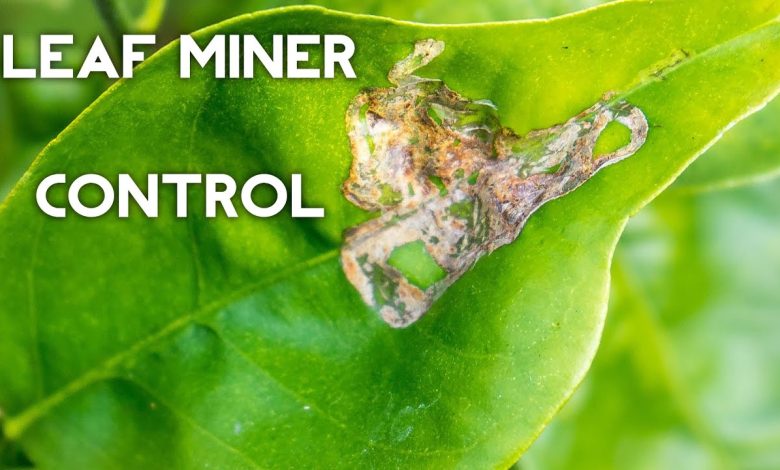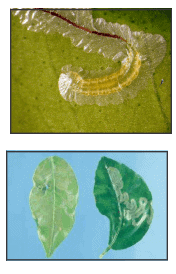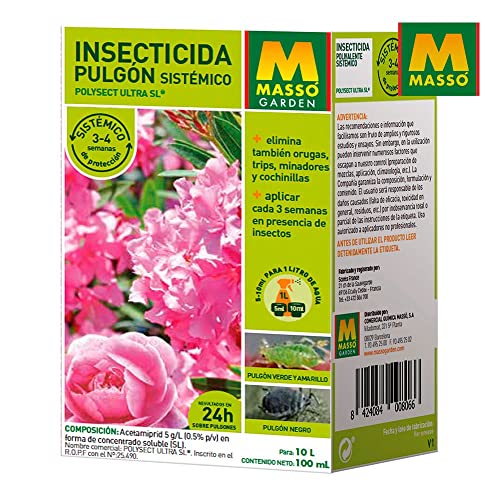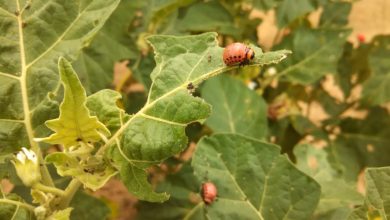Citrus Miner: [How to Identify and Fight It]

 Citrus leafminer larvae feed by creating shallow tunnels, or mines, in the young leaves of citrus trees. The pest is most commonly found on citrus (oranges, tangerines, lemons, limes, grapefruit, and other varieties) and closely related plants (kumquat and calamondin).
Citrus leafminer larvae feed by creating shallow tunnels, or mines, in the young leaves of citrus trees. The pest is most commonly found on citrus (oranges, tangerines, lemons, limes, grapefruit, and other varieties) and closely related plants (kumquat and calamondin).
Other leafminer-type pests (including citrus fruit and stem miner) attack weeds, ornamentals, and crop plants, but citrus leafminer is the only insect miner that usually attacks citrus leaves.
Characteristics of this pest
- Common Name: Citrus leafminer, Citrus leafminer, CLM, Citrus serpentine miner.
- Scientific name: Phyllocnistis citrella Stainton.
- Family Gracillariidae: Origin Asia.
- Affected plants: Citrus: oranges, tangerines, lemons, grapefruit, limes, kumquats, calamondins. Non-citrus:Orange Jasmine (Murraya paniculata), Sea Buckthorn (Severinia buxifolia).
- Common Remedies: Pick heavily infected leaves by hand and control the sprouting of new leaves. Thorns and horticultural oils can be used during the outbreak. Most of the time, this pest is a nuisance rather than a serious problem, so it’s best not to take any further action.
What you need to know before you start about citrus leafminer
- This insect attacks all varieties of citrus.
- Larvae infest young foliage, producing a snake-like «mine» as they feed. This causes the leaves to twist and curl.
- The larvae can also attack fruits and stems, although this is more rare.
- Severe infestations can stunt the growth of young trees. Infestations in older trees (over five years) can cause unsightly damage, but do not normally cause significant yield loss.
- In Western Australia, attacks are most severe in late autumn, peaking in April or May, depending on temperature.
- In spring, damage is less as the leafminer population is lower. As a result, only a small proportion of the prolific spring shoot is attacked.
What are citrus leafminers?
Phyllocnistis citrella Stainton is a small, silvery-white moth that is only about 2mm long and has a wingspan of about 5mm.
Although they can be seen with the naked eye, they often go unnoticed due to their size. This tiny moth has ridged wings with brown and white markings ending in a distinctive black spot at the tip of each wing.
They are nocturnal and are most active from dusk to dawn, which is when mating occurs. During their lifetime, from about 2 to 12 days, adult females mate and lay up to 50 eggs on the undersides of young citrus leaves, near the midrib or veins. Each egg looks like a tiny drop of water. A single leaf can be affected by multiple larvae.
Older leaves are not as vulnerable because they have hardened and are difficult for larvae to penetrate.
History of this plague
The citrus leafminer is native to Asia. In the 1940s it was first noted as a pest in Australia and in the 1970s it appeared in other major citrus growing areas of the world. It arrived in Florida in 1993 and began to make its way west, invading northern Mexico in the mid-1990s and eventually California.
How can we identify the citrus leafminer?
 The citrus leafminer is a very small, light-colored moth less than 6 millimeters long.
The citrus leafminer is a very small, light-colored moth less than 6 millimeters long.
It has silver and white forewings, with brown and white markings and a distinctive black spot on the tip of each wing. The hindwings and body are white, with long fringed scales extending from the trailing margins.
The larval stage occurs only within the leaf mines of citrus and other closely related plants. As it feeds and develops, the larva leaves a trail of feces, seen as a thin dark line, within the serpentine mine just below the leaf surface.
This visual characteristic is used to identify the pest.
In its last stage, the larva emerges from the mine and moves towards the edge of the leaf. It coils the leaf around itself and prepares for adulthood, creating a distorted, coiled leaf.
The citrus moth, a similar moth that attacks citrus, differs from the citrus leafminer in that its larval stages do not leave a trail in the mine and attack fruits and stems more than leaves.
The leafminer pupa is wrapped in a silken cocoon covered with whitish, crystalline ball-shaped structures. Peelminer pupae are usually hidden in cracks and crevices in the bark and can be located anywhere on the tree.
What life cycle does the citrus leafminer have?
 The citrus leafminer has four life stages: egg, larva, pupa, and the adult moth. Adults do not damage plants and live only 1-2 weeks.
The citrus leafminer has four life stages: egg, larva, pupa, and the adult moth. Adults do not damage plants and live only 1-2 weeks.
Adult moths are most active in the morning and evening, spending the day resting on the undersides of leaves, but are rarely seen.
Shortly after emerging from the pupal case, the female moth emits a sex pheromone that attracts males. After mating, the female lays a single egg on the underside of the host’s leaves. On the tree, newly emerged flush-growing leaflets, particularly along the midvein, are the preferred sites for egg-laying (oviposition).
The eggs hatch about a week after being laid.
Newly emerged larvae immediately begin feeding on the leaf, initially producing small, almost invisible mines. As the larva grows, its meandering path of mines becomes more noticeable. Larvae molt 4 times over a 2-3 week period as they develop.
The larva emerges from the mine as a prepupa and rolls the edge of the leaf causing a leaf curl. Within that ruffled leaf edge the leafminer pupates. The pupal stage lasts from 1 to 3 weeks.
The entire life cycle of the insect takes 3 to 7 weeks to complete.
What damage can the citrus miner cause?
 The citrus leafminer can survive as a larva only on the tender, young, shiny leaf blush of citrus and closely related species.
The citrus leafminer can survive as a larva only on the tender, young, shiny leaf blush of citrus and closely related species.
Older leaves that have hardened off are not susceptible unless there are extremely high populations. The larvae lodge inside the upper or lower surface of new leaves, causing them to curl and appear distorted.
Mature trees (over 4 years old) that have a dense canopy of old foliage to support them can tolerate damage to new leaves for part of the growing season with negligible effect on tree growth and yield. the fruits.
Very young trees do not have much mature foliage and produce more blush throughout the year, thus supporting larger populations of citrus leafminers.
Young trees may experience reduced growth. However, even young trees with large leafminer populations are unlikely to die.
Summer heat appears to suppress leafminer populations, but in cooler coastal areas, the insect population can remain high from summer through fall.
 The chain growth of citrus trees attacked by the leafminer will look unsightly, but the best course of action is to leave it alone and let the natural enemies of the citrus leafminer feed on and parasitize the plants. larvae in the mines, instead of trying instead of trying to control this pest with insecticides.
The chain growth of citrus trees attacked by the leafminer will look unsightly, but the best course of action is to leave it alone and let the natural enemies of the citrus leafminer feed on and parasitize the plants. larvae in the mines, instead of trying instead of trying to control this pest with insecticides.
In other areas of the world where citrus leafminer invasion is long established, the experience has been similar: a high level of damage to citrus in the first year or two is followed by a decrease in severity due to that natural enemies parasitize or consume leafminers.
These natural enemies, which are already present in the environment, survive by searching for mining insects in which to lay their eggs. Over time, leafminer populations decline as the population of natural enemies increases.
How to Manage a Citrus Leafminer Infestation
- Insecticide control is difficult because the larvae are protected within their mines. The pupal stage is also protected by the coiled leaf.
- Vegetable oil sprays (eg neem oil) reduce egg numbers by decreasing egg laying. Small moths avoid oil-sprayed surfaces, so sprays should be applied before too many eggs have been laid.
- Two or more sprays may be necessary when new leaves are produced over an extended period.
- New growth must be protected as soon as it has formed. Once the leaves have hardened, they are resistant to leafminer attack.
- There are several ways to reduce infestations by limiting the production of new leaves when the number of leafminers is higher:
- Prune the shoots that grow and in which we have identified the citrus leafminer.
- Fertilize in late winter to promote strong spring growth when leafminer is rarer.
- Do not over-water or over-fertilize in late summer and fall.
Ecological control of citrus leafminer
Products containing the popular plant insecticide spinosad have shown some efficacy against citrus leafminer.
For younger trees, apply the product according to the directions on the container and spray only the young leaves that are vulnerable to moths. Spinosad does not stay on plants for long and will need to be reapplied every few weeks and after heavy rains.
Horticultural oil, including neem oil, is also sometimes used by farmers and private individuals during budding and sprayed on developing leaves. The oils can help inhibit the hatching of the eggs. Keep spraying the leaves for 10-14 days until they have hardened.
Citrus Leafminer Control
Citrus farmers can use sex pheromone sticky traps to control the pest population, but these traps only attract males.
Although these traps alone are not enough to suppress the pest population, they can provide an estimate of the degree of infestation. If you need help identifying the insects in your sticky traps, you can send them to the town hall or official office in your area.
Picking heavily infested leaves by hand is a common control to keep leafminer populations low. The collected leaves can be dropped into a bucket of soapy water to drown the larvae.
Avoid pruning too many leaves, as undamaged parts or leaves can still photosynthesize.
Also, avoid pruning live citrus branches more than once a season and don’t apply nitrogen fertilizer when there is a heavy infestation of citrus leafminers.
Both of these actions will disrupt citrus sprouting cycles and aggravate the pest problem. Vigorous shoots may develop above the graft union of mature trees. These shoots can attract adult moths to lay eggs. Removing these shoots can help deter adults.
Optimum conditions for leafminer infestations are between 23 and 26º C and a relative humidity greater than 60%. They are more likely to thrive in cooler coastal environments. However, it is a pest that has the potential to spread geographically with rising global temperatures, especially in spring and autumn.
Biological control of citrus leafminer
It is important to protect natural enemies of the citrus leafminer, such as various species of parasitic wasps.
These wasps, such as Ageniaspis citricola and Cirrospilus coachellae, lay their eggs directly in leaf miner tunnels. Once the eggs of these wasps hatch, their larvae will consume the citrus leafminer larvae. Normally it is not necessary to introduce these natural enemies into the environment, since they are already present.
Other Insecticide Controls
It may be overkill to use additional chemical control to control this pest due to potential damage to natural enemies of the citrus leafminer. Many of these insecticides are not effective because it is difficult to get below the surface of the leaves into the tunnels and contact the larvae.
On mature citrus trees, citrus leafminer rarely causes serious damage and management is typically limited to practices that limit succulent growth and protect natural enemies.
Very young trees are more vulnerable to injury and may sometimes warrant insecticide treatment.
However, available tree insecticides are not very effective, and many products leave residues that kill natural enemies, compounding problems.
Frequently Asked Questions About Citrus Leafminer
How is citrus leafminer removed?
This pest is not a serious threat to older trees and usually only attacks young leaves.
Pick infected leaves by hand when you detect leafminer damage and try not to use harsh chemicals that can harm their natural enemies. These natural enemies should suppress leafminer populations without the need for additional controls. Even young trees can recover from a leafminer infestation.
Do miners spread?
Leaf miners are considered an invasive pest because of their rapid spread beyond Asia. There can be several generations per growing season, so the longer the pest population is left unchecked, the faster it can reproduce.
What do miners become?
Leafminer larvae develop into small, light-colored moths with iridescent white forewings and hindwings with a telltale black dot on the wingtips.
Can you eat plants with leaf miners?
Citrus leafminer does not directly affect citrus as it tends to attack leaves during shoot growth. The kafir lime is one of the few citrus species that is consumed for its leaf. If you happen to eat a leafminer-infected leaf, it won’t do you any more harm than the yuck factor.
How long does it take for leaf miner eggs to hatch?
Adult females mate and lay eggs immediately after emerging from their pupal stage. Leafminer eggs hatch in 4 to 10 days, depending on temperature.



![Photo of Tuta Absoluta o Polilla del Tomate: [Cómo Identificarla y Combatirla]](https://www.complete-gardening.com/wp-content/uploads/2022/08/tuta-absoluta-o-polilla-del-tomate-como-identificarla-y-combatirla.jpg)

![Photo of Hydroponics or Hydroponic Cultivation: [Concept, Characteristics and Use]](https://www.complete-gardening.com/wp-content/uploads/2022/08/hydroponics-or-hydroponic-cultivation-concept-characteristics-and-use-390x220.png)